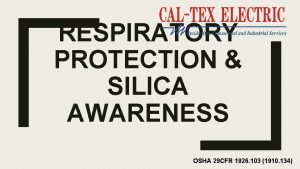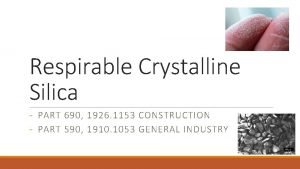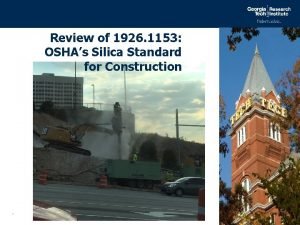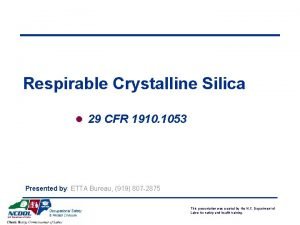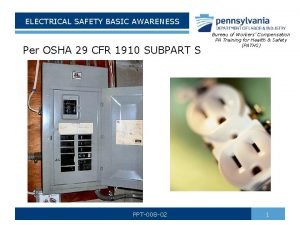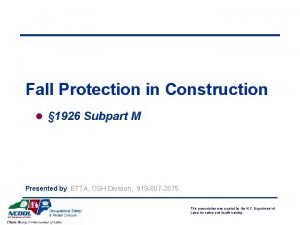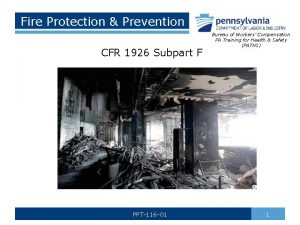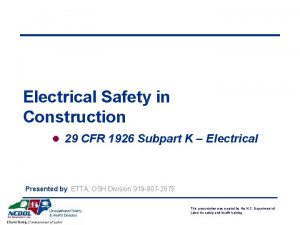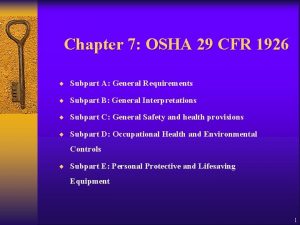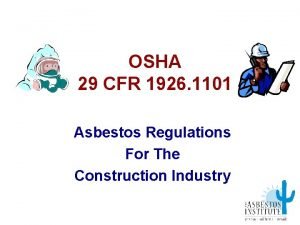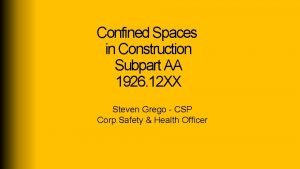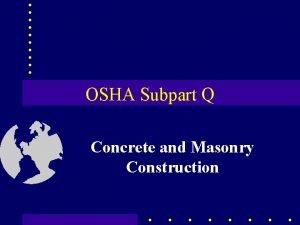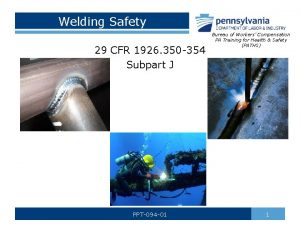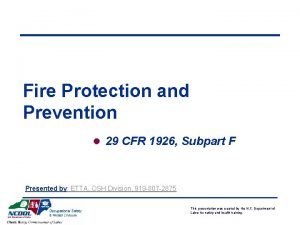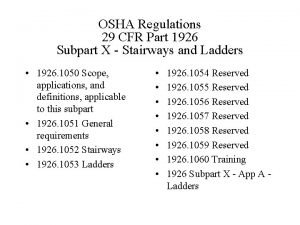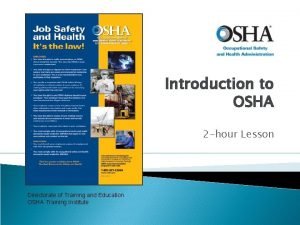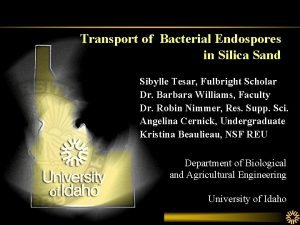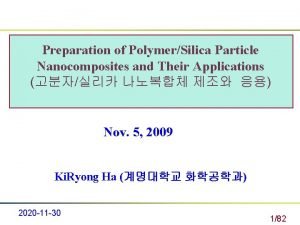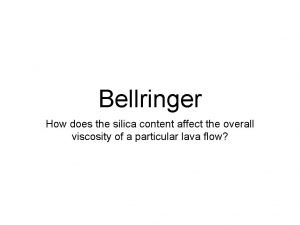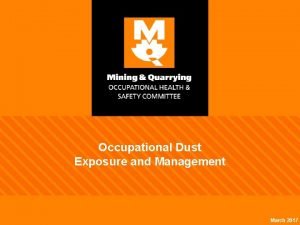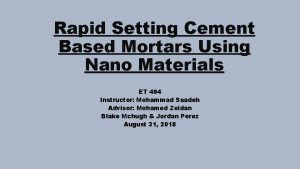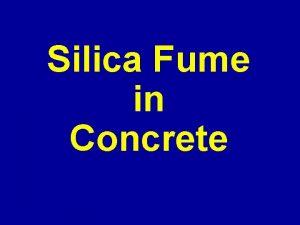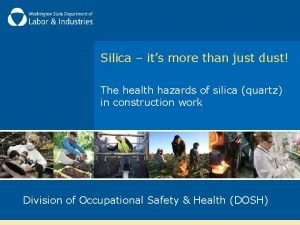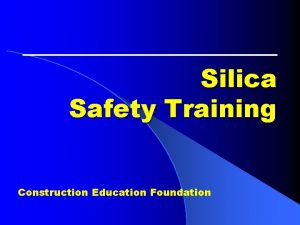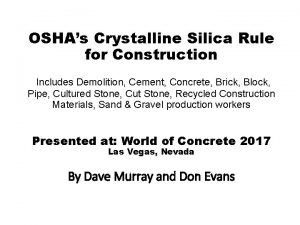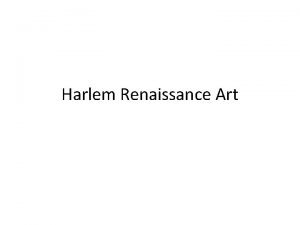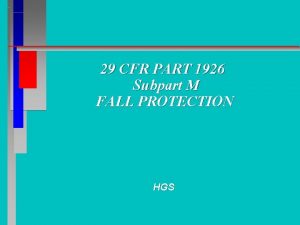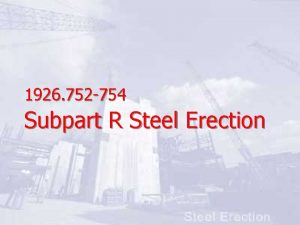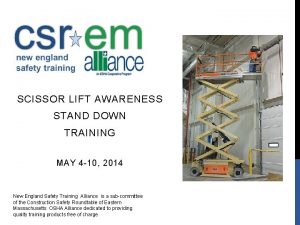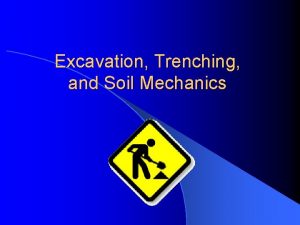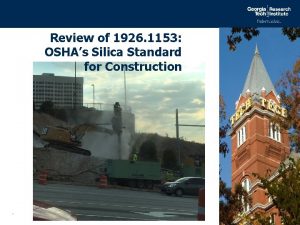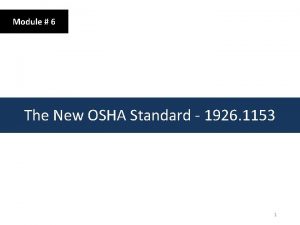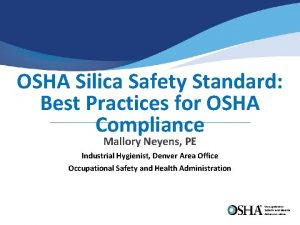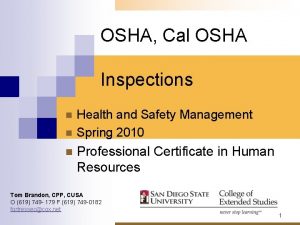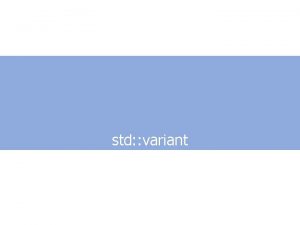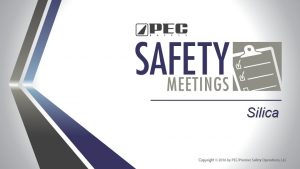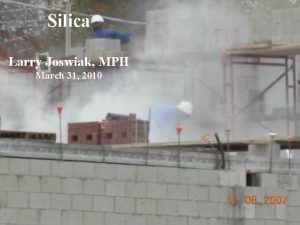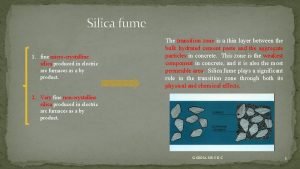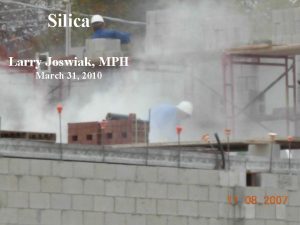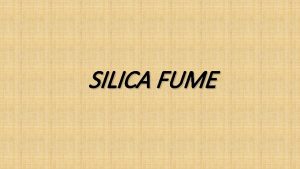Silica in Construction OSHA Std 1926 1153 https











































- Slides: 43

Silica in Construction OSHA Std. 1926. 1153 https: //youtu. be/Dnd. AO 32 Bdvw

Silica in Industry OSHA Std. 1910. 1053

What is Silica? Silica is Quartz (silica) is found naturally in almost all rock, sand soil. It is also found in concrete products and bricks. It is sometimes found in sandblasting (abrasive blasting) grit and is called “silica sand”.

WORKPLACE EXPOSURES • OSHA reports 2. 2 million workers are exposed to respirable crystalline silica. • The majority (1. 85 million) are in the construction industry. • Exposures occur when workers cut, grind, crush, or drill silica-containing materials.

Silica Health Hazards Inhaled silica dust scars the lungs A lung disease called “silicosis” is caused by breathing of dust containing silica. The dust causes “fibrosis” or scar tissue formation in the lungs. This reduces the lung’s ability to extract oxygen from the air. There is no cure!

Silica Health Hazards What are the symptoms of silicosis? Early stages go unnoticed. Continued exposure results in shortness of breath during exercise. Prolonged high exposure can lead to extreme shortness of breath, chest pain, respiratory failure and death. 6

‘TYPES’ OF SILICOSIS • Simple chronic silicosis – From long-term exposure (10 -20 years) to low amounts of silica dust. • Accelerated silicosis – Occurs after exposure to larger amounts of silica over a shorter period of time (5 -10 years). • Acute silicosis – From short-term exposure to very large amounts of silica dust.

Lung Cancer • There is an association between silicosis and lung cancer • Over 500 silica related lung cancer deaths in construction in 2004 – Over 10 a week • Silica is the second most important cause of occupational lung cancer after asbestos

Chronic Obstructive Pulmonary Disease (COPD) • Persistent obstruction of airflow into lungs • Irreversible (unlike asthma) • Progressive • Main cause is smoking • Silica exposure associated with COPD • Construction workers 2 to 3 times risk • Symptoms: breathlessness, cough with phlegm

What’s the Problem?

Why is it a Problem? • Particles need to be “respirable” to cause harm • Issue is Respirable Crystalline Silica or RCS • RCS particles can penetrate to deep lung https: //www. youtube. com/watch? v=R_s. C 2 w. X 9 Uwc

Why is it a Problem? • • • A micron is one millionth of a meter. Human hair varies between 40 to 100 m thick. Respirable dust = 10 m or less

OSHA Silica Standard • September 2013, OSHA published a Notice of Proposed Rulemaking (NPRM) for Occupational Exposure to Respirable Crystalline Silica. • First update since the original Permissible Exposure Limit (PEL) was adopted in 1971. • On March 25, 2016, OSHA published the long-awaited final rule.

CFR 1926 Respirable Crystalline Silica a) b) c) d) e) f) g) h) i) j) k) Scope and application Definitions Specified exposure control methods (Table 1) Alternative exposure control methods Respiratory protection Housekeeping Written exposure control plan Medical examination Communication of hazards Recordkeeping Dates

Scope and Application • Applies to all occupational exposures to respirable crystalline silica in construction work, except where employee exposure will remain below 0. 25 mg/m 3 as an 8 -hour Timeweighed average under any foreseeable conditions.

Written Exposure Control Plan Competent Person • The employer shall designate a competent person to make frequent and regular inspections of job sites, materials, and equipment to implement the written exposure control plan. • Competent Person - an individual who is capable of identifying existing and foreseeable silica hazards in the workplace and who has authorization to take prompt corrective measures to eliminate or minimize them.

Written Exposure Control Plan • Must contain at least the following elements – Description of tasks that involve silica exposure – Description of engineering controls, work practices and respiratory protection used for each task – Description housekeeping methods – Description of procedures used to restrict access to work areas, to minimize the number of employees exposed • Must be evaluated and updated at least annually • Must be readily accessible

New OSHA Limits Passed in 2016 Permissible Exposure Limit (PEL) 50 ug/m 3 as an 8 -hr TWA for all forms of silica including quartz, cristobalite, and Tridymite Action Level 25 ug/m 3 as an 8 -hr TWA (same as current ACGIH TLV)

8 -Hour TWA • TWA = Time - Weighted Average 14 • Levels vary over the shift duration Exposure in PPM 12 10 TWA for 8 6 4 2 0 8: 00 AM 9: 00 AM 10: 00 AM 11: 00 AM 12: 00 PM 1: 00 PM 2: 00 PM Time • These limits protect from chronic diseases • 8 -hr TWA = (C 1 x T 1) + (C 2 x T 2) …. . (Cn x Tn) 480 min 3: 00 PM 4: 00 PM

1926. 1153 (c) Table 1 Specified Exposure Control Methods For each employee engaged in a task identified in Table 1 - Shall implement engineering controls, work practices, and respiratory protection required, unless - Employer assesses and limits the exposure of the employee to respirable crystalline silica in accordance with paragraph (d)

Specified Exposure Control Methods Table 1 • Employers who choose to follow engineering, work practice controls and respirator requirements in Table 1 do not have to conduct sampling or ensure employees are exposed below the PEL.

Specified Exposure Control Methods Table 1 18 Job Tasks covered in Table 1 1. 2. 3. 4. 5. 6. 7. 8. 9. Stationary masonry saws Handheld power saws for cutting fiberglass Walk-behind saws Drivable saws Rig-mounted core saws or drills Handheld and stand-mounted drills Dowel drilling rigs for concrete Vehicle-mounted drilling

Specified Exposure Control Methods Table 1 18 Job Tasks covered in Table 1 (cont. ) 10. Jackhammers and handheld powered chipping tools 11. Handheld grinders for mortar removal 12. Handheld grinders for other uses 13. Walk-behind milling machines and floor grinders 14. Small drivable milling machines 15. Large Drivable milling machines 16. Crushing machines 17. Heavy equipment and utility vehicles used to abrade or fracture silica-containing materials 18. Heavy equipment vehicles for tasks such as grading and excavating

Table 1: Specified Exposure Control Methods

Specified Exposure Control Methods When implementing the control specified in Table 1: – For indoor tasks or tasked in enclosed areas, provided a means of exhaust as needed to to minimize the accumulation of visible airborne dust; – For tasks performed using wet methods, apply water at flow rates sufficient to minimize release of visible dust;

Specified Exposure Control Methods When implementing the control specified in Table 1 – For measures implemented that include an enclosed cab or booth: • Is maintained as free as practicable for settled dust; • Has door seals and closing mechanisms that work properly; • Has gaskets and seals in good condition and work properly • Is under positive pressure maintained through continuous delivery of fresh air; • Has intake air that is filtered through a filter that is 95% efficient

Alternative Exposure Controls • Employer shall ensure no employee is exposed in excess of PEL • Exposure Assessment – employer shall assess exposure of each employee who may be exposed at or above action level 1. Performance Option – Use “objective data” or sampling to determine which tasks are likely to cause exposure over the AL 2. Scheduled Monitoring – Perform initial sampling, for each employee, to determine which tasks cause exposure above the AL, then conduct periodic sampling afterwards

Alternative Exposure Controls 1. Performance Option – Use “objective data” or sampling to determine which tasks are likely to cause exposure over the AL 2. Scheduled Monitoring – Perform initial sampling, for each employee, to determine which tasks cause exposure above the AL, then conduct periodic sampling afterwards

Performance Option Objective Data • Information such as: – Air monitoring data from industry-wide surveys or calculations based on the composition of a substance, demonstrating employee exposure to respirable crystalline silica associated with particular product or material or a specific process, task, or activity. – Data must reflect workplace conditions closely resembling or with higher exposure potential.

Objective Data - Recordkeeping • Shall include at least the following information: – The silica-containing material in questions – The source of objective data – The testing protocol and results of testing; – Description of the process, task, or activity on which the data were based; and – Other data relevant data

Scheduled Monitoring Option • If initial monitoring indicates exposures are below the AL, may discontinue monitoring for those employees • Periodic monitoring – At or above AL = repeat monitoring within 6 months – Above the PEL = repeat monitoring within 3 months – Must repeat monitoring until there are two consecutive measurements below AL

Alternative Exposure Controls • Employee Notification – Within 5 working days after, employer shall notify each affected employee in writing or by posting the results in an appropriate location accessible to all affected employees – When results indicate employees’ exposures are above the PEL, written notification with include the corrective action being taken to reduce exposures to or below the PEL.

Silica and Use of Respirators must be used if silica dust can’t be controlled with water or ventilation or when specified in Table 1 either or Air-purifying respirator with dust cartridge Supplied air respirator

Filtering Facepieces Air inhaled in Air exhaled out

Assigned Protection Factor (APF) Defined: Workplace level of respiratory protection respirators are expected to provide when employer implements a continuing, effective respiratory protection program. Respirators must be selected according to Assigned Protection Factors (APF)

Air Purifying Respirators Half mask filtering facepiece APF = 10 Half mask elastomeric APF = 10 Source: OSHA Small Entity Compliance Guide Original Illustrations created by Attiliis & Associates Full facepiece elastomeric APF = 50

Air Purifying Respirators Loose-Fitting Powered Air-Purifying Respirator (PAPR) APF = 25 Loose-Fitting (Hooded) Powered Air-Purifying Respirator (PAPR) APF = 25/1000 Source: OSHA Small Entity Compliance Guide Original Illustrations created by Attiliis & Associates

Air Purifying Respirators Tight-Fitting Full Facepiece Powered Air-Purifying Respirator (PAPR) APF = 1000 Source: OSHA Small Entity Compliance Guide Original Illustrations created by Attiliis & Associates Tight-Fitting Half Facepiece Powered Air-Purifying Respirator (PAPR) APF = 50

Respiratory Protection Program • Where respirators are required, you need: – Written program – Worksite-specific procedures • Required elements: – Training – Fit testing – Medical evaluations – Care and maintenance – Procedures for respirator selection – Procedures for routine & emergency use

Voluntary Use • If employer permits voluntary use: – Provide information in Appendix D – Implement elements of written program necessary to ensure • Medical ability to use • Cleaned, stored, maintained to not cause health hazard – Exception: Voluntary use of dust masks

Respirator Training is required for anyone who wears a respirator. If you don’t know how to use a respirator properly, you may think your respirator is providing protection when it is not. 27

Housekeeping • Dry sweeping is prohibited unless wet sweeping, HEPA-filtered vacuuming, or other methods are not feasible • Employer shall not allow compressed air to be used to clean clothing or surfaces unless: – Compressed air is used in conjunction with ventilation system – No alternative is feasible

Medical Surveillance Construction • Initial baseline examination must be made available for employees required by standard to use respirator for 30 or more days per year – No cost to employee – Reasonable time and place – Performed by PLHCP • Periodic examinations at least every three years
 1926 silica
1926 silica 1926 silica
1926 silica 1926 silica
1926 silica Osha silica standard 1910
Osha silica standard 1910 1926 subpart m
1926 subpart m Osha 1926 extension cords
Osha 1926 extension cords 29 cfr 1926 subpart m
29 cfr 1926 subpart m Ppt116
Ppt116 1926 subpart v
1926 subpart v 29 cfr 1926. 404(f)(6)
29 cfr 1926. 404(f)(6) Osha 29 cfr 1910 1200
Osha 29 cfr 1910 1200 Osha 1926 asbestos
Osha 1926 asbestos 1926 subpart aa
1926 subpart aa Steel rods and pipes on which forms are lifted
Steel rods and pipes on which forms are lifted Welding safety ppt
Welding safety ppt 1926 fire extinguisher
1926 fire extinguisher Osha 1926 subpart c
Osha 1926 subpart c Power tools ppt
Power tools ppt Alex novás
Alex novás What are the osha construction standards also called
What are the osha construction standards also called Igneous rock
Igneous rock Silica sand transport
Silica sand transport Fumed silica
Fumed silica Mining company profile
Mining company profile How does silica affect lava
How does silica affect lava Silica solubility
Silica solubility What is silica dust
What is silica dust Colloidal silica gun mix
Colloidal silica gun mix Silica fume slurry
Silica fume slurry Silica health hazards
Silica health hazards Silica in foundation
Silica in foundation Silica beaver dam
Silica beaver dam Silica dust abatement
Silica dust abatement Katal. architekt antoni
Katal. architekt antoni Palmer hayden fetiche et fleurs 1926
Palmer hayden fetiche et fleurs 1926 29 cfr 1926 subpart m
29 cfr 1926 subpart m Nowela sierpniowa 1926
Nowela sierpniowa 1926 Multiple lift rigging or christmas treeing
Multiple lift rigging or christmas treeing 1926 ffa
1926 ffa Sissor lift training
Sissor lift training John logue baird
John logue baird Catalan. architekt 1926
Catalan. architekt 1926 Jonah sarcophagus
Jonah sarcophagus 1926 excavation
1926 excavation
